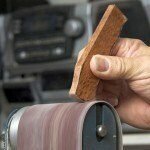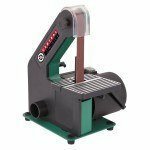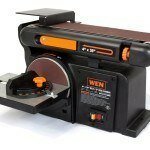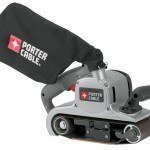Introduction: Belt sanders are popular power tools used by woodworkers across the world. But the household use of this machine is increasing in a significant number. This is because this particular tool has different sizes and two categories. One is used in large volume works and another is in small works. For refinishing your floor, you need a large belt sander. But if you want to refinish your household furniture, a small belt sander can do the job. Depending on your necessity, it is your duty to decide which could be the best belt sander for you.
Doesn’t matter whatever the size of a belt sander is, you can find two rollers in it. One of them generates the energy for belt running, where another keeps belt tension. Belt of this machine does not remain attached to its sander-part; rather shift slightly to spin on the rollers. Though there are many brands can be found in recent days to buy a machine, still it can be said, most of those machines functions almost in the same way. So once you fall in a problem with your belt sander that requires fixing, can be understood all belt sanders of different brands can be fixed in the same way.
Types of Problems That You May Encounter:
There are couples of problems you can encounter while using a belt sander. Some of these can be mechanical, and some of these can be user-handling problems. Mechanical problems are better to be fixed by an expert. For an example, if you find any malfunctioning in the motor, you cannot fix it unless calling an expert. If you find problems in the plugging device, still you need an electrician to call, even though you can try checking the cord and the replacement measures.
But user-handling problems are different than mechanical problems and you can solve it easily while being a non-professional user of a belt sander. Most prominent user-handling based problem is transmitted from the belt of the sander. In a case when you would find the belt has shifted much from the position it should be and not tracking things straight, don’t wait to adjust or to fix the belt immediately. Even in the case of adding a new belt on the roller, proper adjustment is essential to get good stripping results.
How to diagnose what to fix!
While you find things are not working properly, check the diagonal seal around the belt immediately. That might be frayed. In that case, note it, you need to replace it. But if that is yet to fray and seem alright considering its working efficacy, you don’t need to replace the belt, rather it’s time to adjust it properly. This is the way of diagnosing the problem.
Replacing the Belt:
In the case of replacing the belt, you need to release the tension level. You can find that on a side of your sander amid of two rollers. Pull that outward to release, keeping sander away from it. When the level would release, the belt will turn into slack.
Slide and remove the belt from one side of the sander and replace with a new one. While putting a new belt, reverse your process by retightening the lever. To do that, act reverse what you did a while ago. That means, push that inward, heading the sander.
Adjusting the Belt:
In a case of adjusting a belt, whatever that is new or old, switch on the power of your machine and try to find out the direction of the belt riding. Try to understand in which direction it shifts, left side or right. Turn off the power button.
Find the knob of the machine. You can find that closer to front roller. Note down, there are merely 3 controls in the sander; these are the tensioning lever, on or off switch and the knob. If you find the belt is dislodging towards the side where the knob is switched on, make the knob lose by turning counterclockwise. Do clockwise, it the case the belt is dislodging away.
Things to Remember!
While working with a belt sander, you should remain careful, especially when you are in need of some fixing and replacing jobs to perform. Try to read the user manual. Work in a way so your hands remain safe from the roller while it is rolling. In the time of changing belts never forget to make the sander machine unplugged.
Conclusion:
Using the belt sander is easy and so it is in the case of fixing. This machine is made in such a way so the user of it can handle it easily. Still in few cases, a user might encounter distinctive abnormalities and in those cases, he/she should not try to keep using the tool. Always ensure you work with a safe well-tuned belt sander all the times.










